| Luftwaffe late war modeling colors - a small comparison |
Motivation
This particular text would not be public at first, since it just summarizes my personal analysis on which color brand to use on a couple of my latest modeling projects. I wondered, however, that it may be useful to someone facing similar needs. So here it is, a simple analysis on three modeling paint brands for five Luftwaffe late war colors: RLM 74, 75, 81, 82 and 83.
Those were the colors I needed, and not being an expert on the subject (far from that), I didn't want to mix my own colors (although I probably will fade/post shade them on my models). I'be been using a lot of lacquers lately to speed up the painting process on my projects. I know I could use acrylics, but I don't like acrylics to airbrush mottling and such. Neither I like to use different types of paint in the same project, unless absolutely necessary. If possible, I use only lacquers or only enamels or only acrylics. And besides, I had to restrain myself to what I had in my paint stash: sometimes I had one or two colors from one brand but not the others. In summary, I analyzed the following brands here: GSI Creos (Gunze) lacquers (except for one color), Testors Model Master enamels, and Aerotech (a Brazilian modeling brand) nitrocellulose lacquers.
Besides the reasons listed above, I particularly like these brands in view of a few other aspects:
But how about the accuracy of these paints? That's the question I want to answer here.
The colors used in my tests are the following, all thinned with their recommended thinners (SG stands for semi-gloss sheen and G for gloss):
Research
I've not used any scale effect, and keep in mind that fading, washes, post-shading and other techniques can change considerably the final aspect of them on your model. I airbrushed these colors on squared pieces of plastic to compare with my references.
Talking about references, it is virtually impossible to select a definitive pattern for such a controversial subject. References [1] to [5] are among the most reliable sources on the subject, and even them do not match so well to each other. Michael Benolkin made a credible job in crossing many popular hobby paints with these references here and here, but unfortunately he didn't include Mr.Color paints. I still rely on Ref.[5] as my primary source:
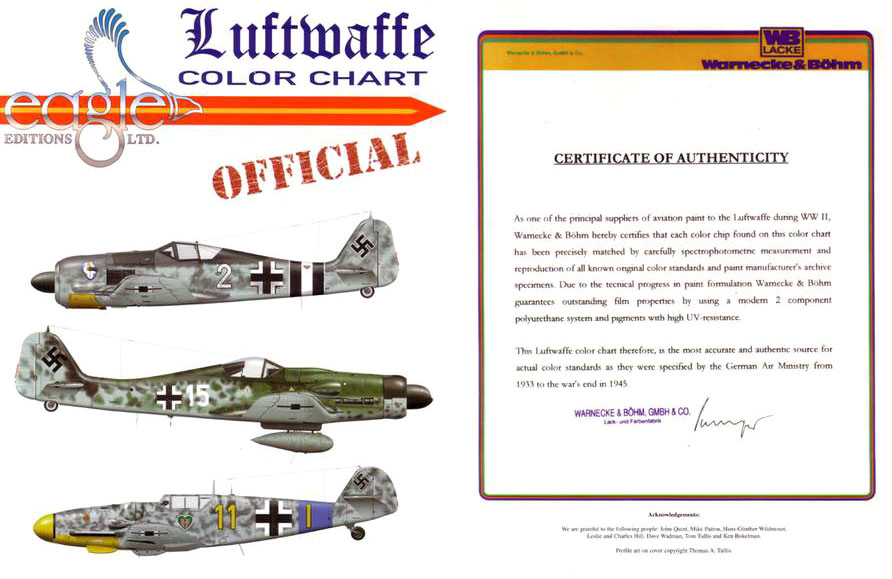
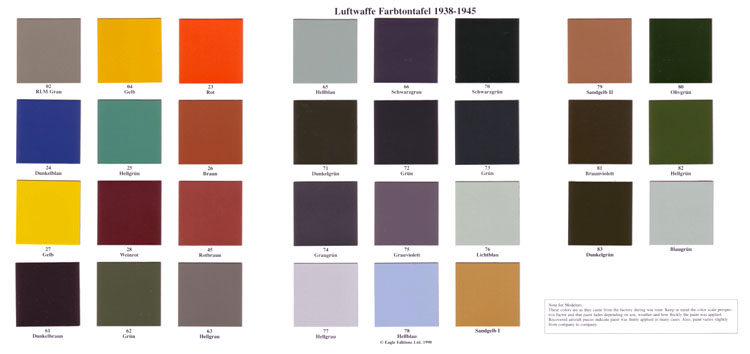
After painting my chips, I ended up with a nice comparison chart. Please note that these are actual photos of the chips, cropped for a better appearence:
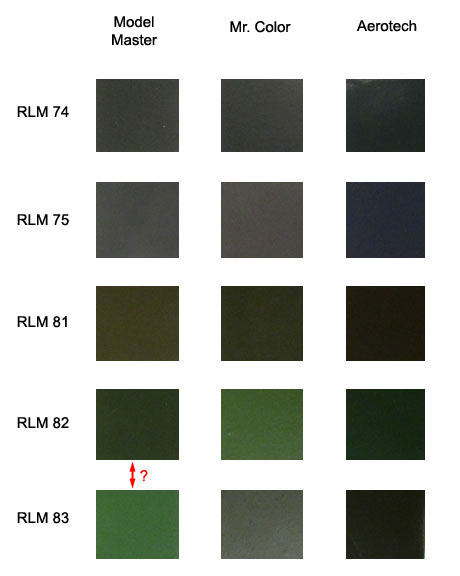
The first thing you note is that Model Master seemed to have switched the colors RLM 82 for 83. I recall reading something about that on the internet, claiming mislabeling or wrong references. On the other hand, the same mistake can be seen on the charts of ref.[1], apparently corrected on refs.[2] and [3], which are actually a revised work on ref.[1]. It is well possible that Testors have used ref.[1] in their RLM 82 and 83 formulas. Who knows? Anyway, I would just switch the labels of these two particular bottles since, as you will see, it makes more sense and the hues are usable.
Testing
I overlaid each paint chip with the ones from ref.[5] to compare them. I also added a RGB interpretation from Mr.Benolkin's digital charts just out of curiosity. Photographed paint chips overlaid with digital tones are almost useless for modeling purposes, but they allow one to check how off the photos could possibly be and adjust the light. I don't need to stress that it is much better to perform such analysis in real life, under natural light. My intention in taking photos instead of scanning the chips was to be closer to how the paint would look like in a (photographed) model. I used the following convention in the comparisons below:

Let's start by the RLM 74:
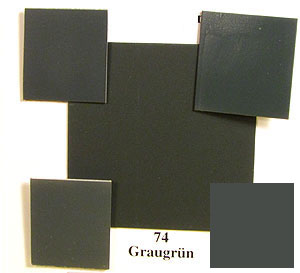
This color has some greenish hue that seems to be absent in Aerotech paints, which is basically a dark grey color. Testors is too light, but may be used on a model accounting for the scale effect. In a direct comparison with ref.[5], my opinion is that Mr.Color is the most accurate.
Next, the RLM 75:
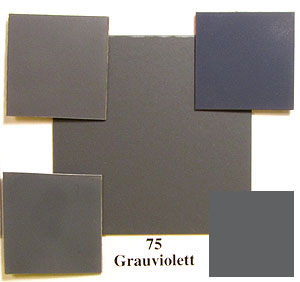
The RLM 75 Grauvilott has a purple hue virtually absent in Aerotech interpretation, way off on the blue side. Both Mr.Color and Model Master versions are good, with the later a tad too dark. Again, I would go with Mr.Color (recalling that I have used Mr.Hobby paints instead of Mr.Color here, but the differences are minimal).
Now the RLM 81:
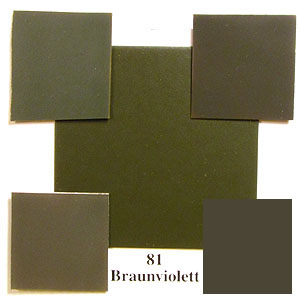
This was a tough one. On a first look, I'd say that Model Master and Aerotech are better than Mr.Color, but both lacks the olive hue captured by the later. I reasoned that Mr.Color, which seems too greenish, would be on-spot if it was a bit lighter. Aerotech is too brownish, while Model Master seems too light. Honestly, I could use any of the analyzed brands here, but it seems a good idea to lighten Mr.Color and Aerotech a tad for modeling purposes.
RLM 82:
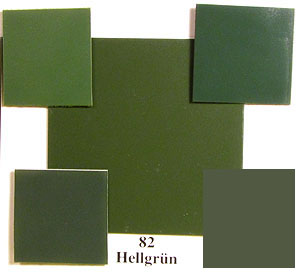
Possibly the easier of the colors analyzed, Mr.Color looked the best of the batch. If you switch Model Master's RLM 82 for 83, you will have a pretty decent RLM 82, too. Aerotech is too dark, but even it can be used by adding a touch of yellow.
And finally, the RLM 83:
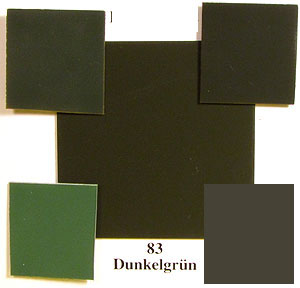
Here my vote goes to Aerotech, which is almost dead-on spot with Eagle Editions. Mr.Color is too greenish, and even if you switch Model Master's RLM 82 for 83, their 83 is also too green.
My humble veridict is the following:
If you have an idea to improve this article, please tell me. Just don't come with that spectrometer talking...
I hope you find this article useful in your next project.
References
[1] - Merrick, K.A., and Hitchcock, T.H., The Official Monogram Painting Guide to German Aircraft 1935-1945, Monogram Aviation Publications, 1980.
[2] - Merrick, K.A., and Kiroff, J., Luftwaffe Camouflage and Markings 1933-1945 Volume 1, Classic Publications, 2004.
[3] - Merrick, K.A., and Kiroff, J., Luftwaffe Camouflage and Markings 1933-1945 Volume 2, Classic Publications, 2005.
[4] - Ullmann, M., Luftwaffe Colours 1935-1945, Hikoki Publications, 2008.
[5] - Luftwaffe Color Chart. Eagle Editions, 1998.
Rato
Marczak
© 2011This particular text would not be public at first, since it just summarizes my personal analysis on which color brand to use on a couple of my latest modeling projects. I wondered, however, that it may be useful to someone facing similar needs. So here it is, a simple analysis on three modeling paint brands for five Luftwaffe late war colors: RLM 74, 75, 81, 82 and 83.
Those were the colors I needed, and not being an expert on the subject (far from that), I didn't want to mix my own colors (although I probably will fade/post shade them on my models). I'be been using a lot of lacquers lately to speed up the painting process on my projects. I know I could use acrylics, but I don't like acrylics to airbrush mottling and such. Neither I like to use different types of paint in the same project, unless absolutely necessary. If possible, I use only lacquers or only enamels or only acrylics. And besides, I had to restrain myself to what I had in my paint stash: sometimes I had one or two colors from one brand but not the others. In summary, I analyzed the following brands here: GSI Creos (Gunze) lacquers (except for one color), Testors Model Master enamels, and Aerotech (a Brazilian modeling brand) nitrocellulose lacquers.
Besides the reasons listed above, I particularly like these brands in view of a few other aspects:
- GSI Creos Mr.Color:
- Lacquer based paints, so they dry fast and allow oil paint dot filtering and washes without a protective clear coat.
- Spray very well.
- The wanted colors are semi-gloss, so again I don't need a gloss coat in preparation for the decals.
- Durable, standing well under a lot of model handling.
- Testors Model Master:
- Easy to use.
- Spray well.
- Very opaque.
- Aerotech:
- Lacquer paints, they dry even faster than Mr.Color and allow oil paint dot filtering and washes without a protective clear coat.
- Spray very well, once you find the proper thinning ratio.
- The wanted colors are gloss, so I can apply the decals directly over them.
- Durable (these are actually automotive paints).
But how about the accuracy of these paints? That's the question I want to answer here.
The colors used in my tests are the following, all thinned with their recommended thinners (SG stands for semi-gloss sheen and G for gloss):
| Mr.Color | Model Master | Aerotech | |
| RLM 74 | #36 (SG) | #2084 Graungrun (SG) | RLM74 (G) |
| RLM 75 | H69 (SG)* | #2085 Grauviolett (G) | RLM75 (G) |
| RLM 81 | #121 (SG) | #2090 Braunviolett (SG) | RLM81 (G) |
| RLM 82 | #122 (SG) | #2091 Dulkelgrun (G) | RLM82 (G) |
| RLM 83 | #123 (SG) | #2092 Lichtgrun (G) | RLM83 (G) |
* Due to shortage of this lacquer color in my stash, I used the H69 from their acrylic line (Hobby Color) instead.
Research
I've not used any scale effect, and keep in mind that fading, washes, post-shading and other techniques can change considerably the final aspect of them on your model. I airbrushed these colors on squared pieces of plastic to compare with my references.
Talking about references, it is virtually impossible to select a definitive pattern for such a controversial subject. References [1] to [5] are among the most reliable sources on the subject, and even them do not match so well to each other. Michael Benolkin made a credible job in crossing many popular hobby paints with these references here and here, but unfortunately he didn't include Mr.Color paints. I still rely on Ref.[5] as my primary source:


After painting my chips, I ended up with a nice comparison chart. Please note that these are actual photos of the chips, cropped for a better appearence:
The first thing you note is that Model Master seemed to have switched the colors RLM 82 for 83. I recall reading something about that on the internet, claiming mislabeling or wrong references. On the other hand, the same mistake can be seen on the charts of ref.[1], apparently corrected on refs.[2] and [3], which are actually a revised work on ref.[1]. It is well possible that Testors have used ref.[1] in their RLM 82 and 83 formulas. Who knows? Anyway, I would just switch the labels of these two particular bottles since, as you will see, it makes more sense and the hues are usable.
Testing
I overlaid each paint chip with the ones from ref.[5] to compare them. I also added a RGB interpretation from Mr.Benolkin's digital charts just out of curiosity. Photographed paint chips overlaid with digital tones are almost useless for modeling purposes, but they allow one to check how off the photos could possibly be and adjust the light. I don't need to stress that it is much better to perform such analysis in real life, under natural light. My intention in taking photos instead of scanning the chips was to be closer to how the paint would look like in a (photographed) model. I used the following convention in the comparisons below:

Let's start by the RLM 74:
This color has some greenish hue that seems to be absent in Aerotech paints, which is basically a dark grey color. Testors is too light, but may be used on a model accounting for the scale effect. In a direct comparison with ref.[5], my opinion is that Mr.Color is the most accurate.
Next, the RLM 75:
The RLM 75 Grauvilott has a purple hue virtually absent in Aerotech interpretation, way off on the blue side. Both Mr.Color and Model Master versions are good, with the later a tad too dark. Again, I would go with Mr.Color (recalling that I have used Mr.Hobby paints instead of Mr.Color here, but the differences are minimal).
Now the RLM 81:
This was a tough one. On a first look, I'd say that Model Master and Aerotech are better than Mr.Color, but both lacks the olive hue captured by the later. I reasoned that Mr.Color, which seems too greenish, would be on-spot if it was a bit lighter. Aerotech is too brownish, while Model Master seems too light. Honestly, I could use any of the analyzed brands here, but it seems a good idea to lighten Mr.Color and Aerotech a tad for modeling purposes.
RLM 82:
Possibly the easier of the colors analyzed, Mr.Color looked the best of the batch. If you switch Model Master's RLM 82 for 83, you will have a pretty decent RLM 82, too. Aerotech is too dark, but even it can be used by adding a touch of yellow.
And finally, the RLM 83:
Here my vote goes to Aerotech, which is almost dead-on spot with Eagle Editions. Mr.Color is too greenish, and even if you switch Model Master's RLM 82 for 83, their 83 is also too green.
My humble veridict is the following:
- If you don't mind mixing paint brands:
- RLM 74: Mr.Color
- RLM 75: Mr.Color
- RLM 81: Any of the three analyzed
- RLM 82: Mr.Color
- RLM 83: Aerotech
- If you want to use a single paint brand, that would be Mr.Color.
If you have an idea to improve this article, please tell me. Just don't come with that spectrometer talking...
I hope you find this article useful in your next project.
References
[1] - Merrick, K.A., and Hitchcock, T.H., The Official Monogram Painting Guide to German Aircraft 1935-1945, Monogram Aviation Publications, 1980.
[2] - Merrick, K.A., and Kiroff, J., Luftwaffe Camouflage and Markings 1933-1945 Volume 1, Classic Publications, 2004.
[3] - Merrick, K.A., and Kiroff, J., Luftwaffe Camouflage and Markings 1933-1945 Volume 2, Classic Publications, 2005.
[4] - Ullmann, M., Luftwaffe Colours 1935-1945, Hikoki Publications, 2008.
[5] - Luftwaffe Color Chart. Eagle Editions, 1998.
